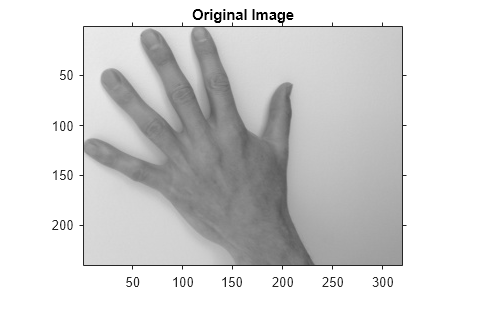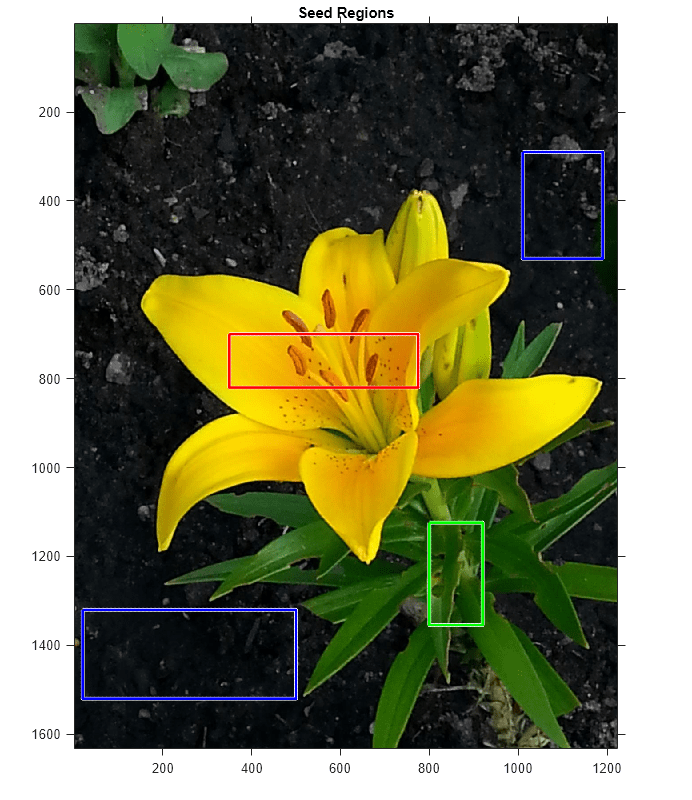jaccard
Jaccard similarity coefficient for image segmentation
Description
similarity = jaccard(BW1,BW2)BW1 and
BW2 divided by the union of BW1 and
BW2, also known as the Jaccard index. The images can be
binary images, label images, or categorical images.
similarity = jaccard(L1,L2)L1
and L2.
similarity = jaccard(C1,C2)C1 and C2.
Examples
Read an image containing an object to segment. Convert the image to grayscale, and display the result.
A = imread('hands1.jpg'); I = im2gray(A); figure imshow(I) title('Original Image')

Use the active contours (snakes) method to segment the hand.
mask = false(size(I)); mask(25:end-25,25:end-25) = true; BW = activecontour(I, mask, 300);
Read in the ground truth against which to compare the segmentation.
BW_groundTruth = imread('hands1-mask.png');Compute the Jaccard index of this segmentation.
similarity = jaccard(BW, BW_groundTruth);
Display the masks on top of each other. Colors indicate differences in the masks.
figure
imshowpair(BW, BW_groundTruth)
title(['Jaccard Index = ' num2str(similarity)])
This example shows how to segment an image into multiple regions. The example then computes the Jaccard similarity coefficient for each region.
Read in an image with several regions to segment.
RGB = imread('yellowlily.jpg');Create scribbles for three regions that distinguish their typical color characteristics. The first region classifies the yellow flower. The second region classifies the green stem and leaves. The last region classifies the brown dirt in two separate patches of the image. Regions are specified by a 4-element vector, whose elements indicate the x- and y-coordinate of the upper left corner of the ROI, the width of the ROI, and the height of the ROI.
region1 = [350 700 425 120]; % [x y w h] format
BW1 = false(size(RGB,1),size(RGB,2));
BW1(region1(2):region1(2)+region1(4),region1(1):region1(1)+region1(3)) = true;
region2 = [800 1124 120 230];
BW2 = false(size(RGB,1),size(RGB,2));
BW2(region2(2):region2(2)+region2(4),region2(1):region2(1)+region2(3)) = true;
region3 = [20 1320 480 200; 1010 290 180 240];
BW3 = false(size(RGB,1),size(RGB,2));
BW3(region3(1,2):region3(1,2)+region3(1,4),region3(1,1):region3(1,1)+region3(1,3)) = true;
BW3(region3(2,2):region3(2,2)+region3(2,4),region3(2,1):region3(2,1)+region3(2,3)) = true;Display the seed regions on top of the image.
figure imshow(RGB) hold on visboundaries(BW1,'Color','r'); visboundaries(BW2,'Color','g'); visboundaries(BW3,'Color','b'); title('Seed Regions')

Segment the image into three regions using geodesic distance-based color segmentation.
L = imseggeodesic(RGB,BW1,BW2,BW3,'AdaptiveChannelWeighting',true);Load a ground truth segmentation of the image.
L_groundTruth = double(imread('yellowlily-segmented.png'));Visually compare the segmentation results with the ground truth.
figure imshowpair(label2rgb(L),label2rgb(L_groundTruth),'montage') title('Comparison of Segmentation Results (Left) and Ground Truth (Right)')

Compute the Jaccard similarity index (IoU) for each segmented region.
similarity = jaccard(L, L_groundTruth)
similarity = 3×1
0.8861
0.5683
0.8414
The Jaccard similarity index is noticeably smaller for the second region. This result is consistent with the visual comparison of the segmentation results, which erroneously classifies the dirt in the lower right corner of the image as leaves.
Input Arguments
First binary image, specified as a logical array of any dimension.
Data Types: logical
Second binary image, specified as a logical array of the same size as
BW1.
Data Types: logical
First label image, specified as an array of nonnegative integers, of any dimension.
Data Types: double
Second label image, specified as an array of nonnegative integers, of the
same size as L1.
Data Types: double
First categorical image, specified as a categorical array of any
dimension.
Data Types: category
Second categorical image, specified as a categorical array of the
same size as C1.
Data Types: category
Output Arguments
Jaccard similarity coefficient, returned as a numeric scalar or numeric
vector with values in the range [0, 1]. A similarity of
1 means that the segmentations in the two images are a perfect match. If the
input arrays are:
binary images,
similarityis a scalar.label images,
similarityis a vector, where the first coefficient is the Jaccard index for label 1, the second coefficient is the Jaccard index for label 2, and so on.categorical images,
similarityis a vector, where the first coefficient is the Jaccard index for the first category, the second coefficient is the Jaccard index for the second category, and so on.
Data Types: double
More About
The Jaccard similarity coefficient of two sets A and B (also known as intersection over union or IoU) is expressed as:
jaccard(A,B)
= |
intersection(A,B)
| / | union(A,B)
|
where |A| represents the cardinal of set A. The Jaccard index can also be expressed in terms of true positives (TP), false positives (FP) and false negatives (FN) as:
jaccard(A,B)
= TP / (TP + FP +
FN)
The Jaccard index is related to the Dice index according to:
jaccard(A,B)
= dice(A,B) / (2 -
dice(A,B)
)
Version History
Introduced in R2017b
MATLAB Command
You clicked a link that corresponds to this MATLAB command:
Run the command by entering it in the MATLAB Command Window. Web browsers do not support MATLAB commands.
选择网站
选择网站以获取翻译的可用内容,以及查看当地活动和优惠。根据您的位置,我们建议您选择:。
您也可以从以下列表中选择网站:
如何获得最佳网站性能
选择中国网站(中文或英文)以获得最佳网站性能。其他 MathWorks 国家/地区网站并未针对您所在位置的访问进行优化。
美洲
- América Latina (Español)
- Canada (English)
- United States (English)
欧洲
- Belgium (English)
- Denmark (English)
- Deutschland (Deutsch)
- España (Español)
- Finland (English)
- France (Français)
- Ireland (English)
- Italia (Italiano)
- Luxembourg (English)
- Netherlands (English)
- Norway (English)
- Österreich (Deutsch)
- Portugal (English)
- Sweden (English)
- Switzerland
- United Kingdom (English)